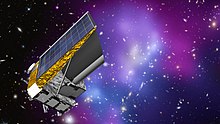Euclid (space telescope)
Euclid - named after the mathematician Euclid of Alexandria - is a space telescope planned by ESA as part of the Cosmic Vision 2015–2025 program for research into so-called dark energy and matter . The space telescope is to begin its journey with a Soyuz rocket from Kourou in June 2022 and reach its destination, the second Lagrange point ( L 2 for short ), in the Earth-Sun system, after around 30 days . Once there, the telescope will explore space for around six years.
Structure and further details
Euclid will use two instruments, both of which will look through a 1.2 m Korsch telescope with three mirrors and 24.5 m focal length and observe the same area of the sky. The telescope should be passively and actively cooled for noise suppression. One instrument works in the visible and one in the near infrared range of the electromagnetic spectrum . The instrument in the visible spectral range uses several CCDs arranged next to one another . The telescope has several filter wheels in the infrared spectral range and can take photos or spectra in the infrared range.
In Astrium's design proposal for Euclid, the first two of the three telescope mirrors should be made of silicon carbide . In the design proposal by Thales Alenia Space for Euclid, these telescope mirrors should consist of glass ceramic , which are stabilized by a support structure made of silicon nitride .
Euclid can rotate around itself in 80 minutes to position the image field.
Euclid will send the measurement results and stored telemetric data in the K-band (26 GHz) via a movable antenna to the ground station at Cebreros in Spain when the telescope is visible from Earth. Telemetry is not only transmitted in the K-band, but also in the X-band , Euclid is also controlled via the X-band. Euclid will transmit four hours a day in the K-band to transmit a maximum of 855 gigabits. The large amount of data expected from Euclid made it necessary to further expand the data processing of the ESTRACK antenna network . The data rate of the network in Cebreros and Malargüe was expanded from 10 Mb / s to 147 Mb / s, and in addition, Malargüe was expanded to include Ka-band reception (26 GHz).
history
The contracts with the institutes involved that will build the two scientific instruments were signed on June 20, 2012. Then the construction of the spacecraft was put out to tender.
On January 24, 2013 it was announced that NASA would supply sensors for Euclid's infrared instrument. US scientists are involved in Euclid.
Astrium in Toulouse won the order for the Euclid payload module on June 11, 2013. The telescope mirrors made of silicon carbide proposed by Astrium are obtained.
Thales Alenia Space was selected as the prime contractor for Euclid on June 27, 2013. TAS builds the Euclid spacecraft. The Astrium payload module with telescope mirrors made of silicon carbide is installed in this.
swell
- Euclid definition study report (Red Book); ISSUE 1.1 (English; PDF with 17 MB), on ESA Science & Technology on September 29, 2011; Retrieved October 11, 2011.
Web links
- Euclid Consortium: Euclid and the origin of the accelerating universe (English)
- Euclid pages at ESA's Science & Technology (English)
- Stephen Clark: Europe plans solar orbiter and dark energy probe in Spaceflight Now, October 8th 2011, Accessed: 11 October 2011 (English)
- Editor, press releases from the University of Bonn and the MPE: EUCLID, ESA satellite to explore the dark universe , in Astronews.com, date: June 20, 2012, accessed: June 21, 2012
- Lecture by Frank Grupp, among others, about Euclid
Individual evidence
- ↑ Missions . ESA Science & Technology, accessed December 27, 2018.
- ↑ Mission Summary sci.esa.int
- ↑ a b In Search of Dark Energy: The New Euclid Space Telescope , DLR on June 20, 2012; Retrieved April 27, 2015
- ↑ a b TAS main contractor for ESA telescope Euclid , Thomas Weyrauch on Raumfahrer.net on June 28, 2013; Retrieved April 27, 2015
- ↑ Euclid Consortium: Mission characteristics. December 27, 2017, accessed February 26, 2018 .
- ^ Doing up the deep dish. Retrieved April 28, 2019 (UK English).
- ↑ Dark Universe mission blueprint complete (English), ESA on June 20, 2012; Retrieved April 27, 2015
- ↑ Euclid is supposed to bring light into the darkness , Michael Clormann on Raumfahrer.net on January 25, 2013; Retrieved April 27, 2015
- ^ NASA signs on to European dark energy mission (English), Stephen Clark on Spaceflightnow.com on January 25, 2013; Retrieved April 27, 2015
- ↑ Euclid to probe dark Universe with Astrium science module (English), ESA on June 11, 2013; Retrieved April 27, 2015
- ↑ Airbus Defense and Space is awarded the Euclid Payload Module contract by ESA (English), Airbus Defense and Space on June 11, 2013; Retrieved April 27, 2015
- ↑ Thales Alenia Space wins prime contract for Europe's Euclid cosmology satellite ( Memento of November 4, 2016 in the Internet Archive ) (English), Thales Group on June 27, 2013; Retrieved April 27, 2015

